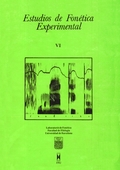Pistas acústicas y perceptivas en la distinción de oclusivas en inicio absoluto e intervocálicas en coreano
Abstract
The Korean language shows a phonological distinction between three types of stops. The overall purpose of this research is to study the acoustic parameters that allow native speakers of the Seoul standard dialect to differentiate between the three stop series, which are the following: series 1 stops: voiceless, lax, slightly aspirated; as follows show voiced allophones between voiced segments, typically vowels; series 2 stops: voiceless, tense, non-aspirated; series 3 stops: voiceless, tense, heavily aspirated. These features draw a distinction between nine consonant phonemes. The starting point of this analysis is a corpus of data obtained from native speakers of Korean, who subsequently went through three different perception tests (described in section 2.2). These tests were meant to study which clues allow the discrimination of the three stops series: a) the tension feature (as claimed in Kim 1965) or 2) VOT (as suggested in Lisker and Abramson 1964). The data obtained from the perception tests suggest a) that the voicing lag is not an absolute clue, as speakers do not differentiate between lax and tense series on this basis, although they do distinguish between the tense, heavily aspiraded series 3 and the tense, non-aspirated series 2; and b) that the tension feature, shown off in different acoustic parameters (previous-vowel duration, following-vowel intensity, intervocalic silence duration), is a crucial clue in the discrimination of the different types of Korean stops.
Downloads
Published
How to Cite
Issue
Section
License

This work is licensed under a Creative Commons Attribution-NonCommercial-NoDerivatives 4.0 International License.
All articles published online by Estudios de Fonética Experimental are licensed under Creative Commons Attribution-NonCommercial-NoDerivs 4.0 International (CC BY-NC-ND 4.0 DEED), unless otherwise noted. Estudios de Fonética Experimental is an open access journal. Estudios de Fonética Experimental is hosted by RCUB (Revistes Científiques de la Universitat de Barcelona), powered by Open Journal Systems (OJS) software. The copyright is not transferred to the journal: authors hold the copyright and publishing rights without restrictions. The author is free to use and distribute pre and post-prints versions of his/her article. However, preprint versions are regarded as a work-in-progress version used as internal communication with the authors, and we prefer to share postprint versions.




